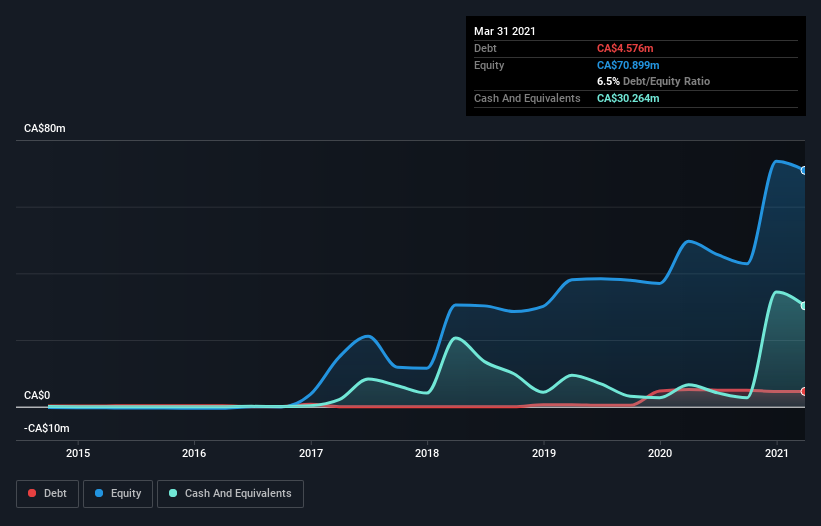Health Check: How Prudently Does Standard Lithium (CVE:SLI) Use Debt?
Some say volatility, rather than debt, is the best way to think about risk as an investor, but Warren Buffett famously said that 'Volatility is far from synonymous with risk.' So it might be obvious that you need to consider debt, when you think about how risky any given stock is, because too much debt can sink a company. As with many other companies Standard Lithium Ltd. (CVE:SLI) makes use of debt. But is this debt a concern to shareholders?
What Risk Does Debt Bring?
Debt is a tool to help businesses grow, but if a business is incapable of paying off its lenders, then it exists at their mercy. Ultimately, if the company can't fulfill its legal obligations to repay debt, shareholders could walk away with nothing. While that is not too common, we often do see indebted companies permanently diluting shareholders because lenders force them to raise capital at a distressed price. Of course, the upside of debt is that it often represents cheap capital, especially when it replaces dilution in a company with the ability to reinvest at high rates of return. When we examine debt levels, we first consider both cash and debt levels, together.
View our latest analysis for Standard Lithium
What Is Standard Lithium's Debt?
As you can see below, Standard Lithium had CA$4.58m of debt at March 2021, down from CA$5.15m a year prior. However, it does have CA$30.3m in cash offsetting this, leading to net cash of CA$25.7m.
How Healthy Is Standard Lithium's Balance Sheet?
Zooming in on the latest balance sheet data, we can see that Standard Lithium had liabilities of CA$1.50m due within 12 months and liabilities of CA$4.70m due beyond that. Offsetting these obligations, it had cash of CA$30.3m as well as receivables valued at CA$152.0k due within 12 months. So it can boast CA$24.2m more liquid assets than total liabilities.
Having regard to Standard Lithium's size, it seems that its liquid assets are well balanced with its total liabilities. So it's very unlikely that the CA$1.22b company is short on cash, but still worth keeping an eye on the balance sheet. Simply put, the fact that Standard Lithium has more cash than debt is arguably a good indication that it can manage its debt safely. When analysing debt levels, the balance sheet is the obvious place to start. But ultimately the future profitability of the business will decide if Standard Lithium can strengthen its balance sheet over time. So if you want to see what the professionals think, you might find this free report on analyst profit forecasts to be interesting.
Since Standard Lithium has no significant operating revenue, shareholders probably hope it will develop a valuable new mine before too long.
So How Risky Is Standard Lithium?
Statistically speaking companies that lose money are riskier than those that make money. And we do note that Standard Lithium had an earnings before interest and tax (EBIT) loss, over the last year. Indeed, in that time it burnt through CA$18m of cash and made a loss of CA$23m. With only CA$25.7m on the balance sheet, it would appear that its going to need to raise capital again soon. Even though its balance sheet seems sufficiently liquid, debt always makes us a little nervous if a company doesn't produce free cash flow regularly. There's no doubt that we learn most about debt from the balance sheet. However, not all investment risk resides within the balance sheet - far from it. For example Standard Lithium has 5 warning signs (and 3 which don't sit too well with us) we think you should know about.
Of course, if you're the type of investor who prefers buying stocks without the burden of debt, then don't hesitate to discover our exclusive list of net cash growth stocks, today.
This article by Simply Wall St is general in nature. We provide commentary based on historical data and analyst forecasts only using an unbiased methodology and our articles are not intended to be financial advice. It does not constitute a recommendation to buy or sell any stock, and does not take account of your objectives, or your financial situation. We aim to bring you long-term focused analysis driven by fundamental data. Note that our analysis may not factor in the latest price-sensitive company announcements or qualitative material. Simply Wall St has no position in any stocks mentioned.
Have feedback on this article? Concerned about the content? Get in touch with us directly. Alternatively, email editorial-team (at) simplywallst.com.

 Yahoo Finance
Yahoo Finance 
